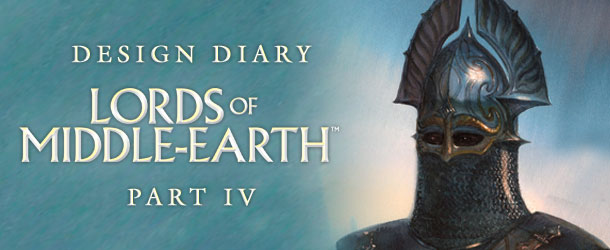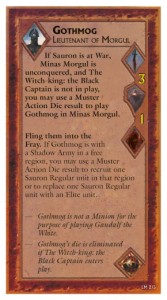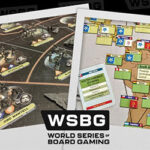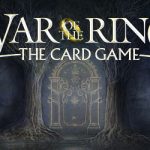Possibly one of the most controversial new characters in the 1st edition expansion, Battles of the Third Age, was the alternate version of the Witch-king, the Chief of the Ringwraiths.
The Chief of the Ringwraiths was originally designed to be an alternative to the “main” version of the Witch-king, the Black Captain. The Black Captain was supposed to be a powerful military leader, while the Chief of the Ringwraiths represented a “what-if” in the storyline – what if Sauron decided to use his most powerful servant to harass the Fellowship, rather than to lead his armies?
However, in spite of all attempts to make the Chief of the Ringwraiths an interesting option, he always remained a pale shadow of the Black Captain: expert players of War of the Ring 1st Edition had found ways to make the Black Captain the ultimate weapon of destruction in the hands of the Shadow player. Thanks to his ability of drawing Event cards when initiating a battle, the Black Captain was mainly used not to fuel the military action of the Shadow armies (as we expected), but to draw intensively from the Character Event deck, to get all kinds of nasty effects to use against the Fellowship. This was actually an abuse of the original intention in the design, and such a powerful ability made the creation of an alternate version more suited to hunting the Fellowship almost impossible. Very few good players would consider mustering the 1st edition Chief of the Ringwraiths instead of the original version.
The Second Edition modified the rules for the Witch-king, in order to bring the Black Captain’s abilities closer to their intended use – leaving him and his armies still powerful in battle, but reducing his use to fuel a strategy focused on corrupting the Ring-bearers. This was already an important step in making the option of an alternate Witch-king, with a focus on the Hunt for the Ring, more interesting. We wanted to get the Chief of the Ringwraiths back, and at the same time, we wanted to be sure that we did not miss the chance to create an interesting new character for the Shadow for the second time.
The solution we found was nicely symmetrical to the powers of the Black Captain. The Black Captain draws cards when engaged in battle: the Chief of the Ringwraiths should have a similar ability, to draw cards when he is on top of the Fellowship. In this way, the Shadow player may use this character to create a focused Corruption strategy, getting him to relentlessly pursue the Ring, draw lot of Event cards, and use them to throw all kinds of nasty things against Frodo and his companions.
We realized that we had more than one way to make the new Witch-king more interesting. To give him a new ability was an option, of course – and we did! But we also started to consider, from the point of view of the narrative, the implications of the alternate storyline. What would happen to the Shadow armies if the Witch-king was hunting the Ring? Who would lead them? The answer lies in the pages of The Lord of the Rings. During the Siege of Minas Tirith, when the Witch-king is vanquished by Eowyn and Merry, it’s Gothmog, Lieutenant of Morgul, who steps forward to lead the Shadow armies and sends the Orcs and Southrons to the battle with a new energy. Based on this event, it’s very likely that, if the Witch-king were not leading hosts of the Shadow, Gothmog would be the Commander-in-Chief.
So, we decided to introduce Gothmog as a new character. Initially, we decided to limit his presence only to the games when the Black Captain does not come into the action. Later in development, we decided to open up more options to the Shadow player, and Gothmog can sometimes co-exist in the same game with the Black Captain – Gothmog must come into play before the Black Captain does, and he’s somewhat reduced in power when he’s in play together with him.
Gothmog is a powerful military leader, but he’s not a Nazgûl, so he is more limited in his movement to the area around Mordor – this worked well for our design goals, as made Gondor a more important military target than the far North of Middle-earth, or Lórien, as it should be.
He has a terrific new ability, “Fling them into the fray”, which gives almost limitless power to a Shadow army, as he can bring new troops into an army no matter where it is on the board – a great ability, especially during sieges, where Gothmog can harass the Free Peoples defenders with multiple waves of troops.
Gothmog was definitely a big step in balancing the power of the Elven Ring Keepers… together with the return of the Balrog of Moria.
The Balrog as featured in War of the Ring is a limited presence: just one Event card, which can prove to be nasty when played at a proper time, but which is of limited use otherwise. And who would not like a Balrog figure in the game? We’ve always been convinced that this evil creature should be more “well rounded” than one card.
We already designed the Balrog as one of the characters in Battles of the Third Age. The Balrog was designed around the idea that he was more at ease in the depths of Moria, but that there was also a possibility that, as the Shadow spreads through Middle-earth, it could rise out of the Darkness to stomp the armies of the Free Peoples into the ground… But it’s a demon from the ancient world, and as such it should not be too easy to get him roaming around under the sunlight in the Third Age of Middle-earth. Getting the Balrog out of Moria was possible, but rare (the draw of an appropriate Event card was required), and dangerous (a Will of the West die result removed the Balrog from the game if it was outside Moria). When in Moria, it was still a great threat to the Fellowship, matching its role in the story.
We did not see any necessity of a radical re-design of the Balrog, as these concepts were still valid. The Balrog and Gothmog together provided a good counter-weight to the presence of Elrond and Galadriel… and added cool new characters and figures to the game! The next logical step was to consider that they should bring new action dice into the game, just like the Keepers did. With a specific “Balrog” action die, we could get the random effect of getting the Balrog more active on the scene of the War of the Ring less random than the draw of one card; at the same time, we could give to this powerful minion of the Shadow a higher possibility of entering the battle, while at the same time keeping the original concept that its participation in the war of the Dark Lord cannot be taken for granted.
Balancing the new Free Peoples characters with these two “Lesser” Minions, and using new, special action dice for each of them, soon became the cornerstone of the design of Lords of Middle-earth.
What else did Lords of Middle-earth need to become a complete expansion? And in detail, how should the new special action dice relate to the existing action dice system?
The core of the expansion was defined, but there was still a lot to do to flesh it out, and to make sure that the new elements added new and interesting strategies without breaking the delicate balance of the game…












